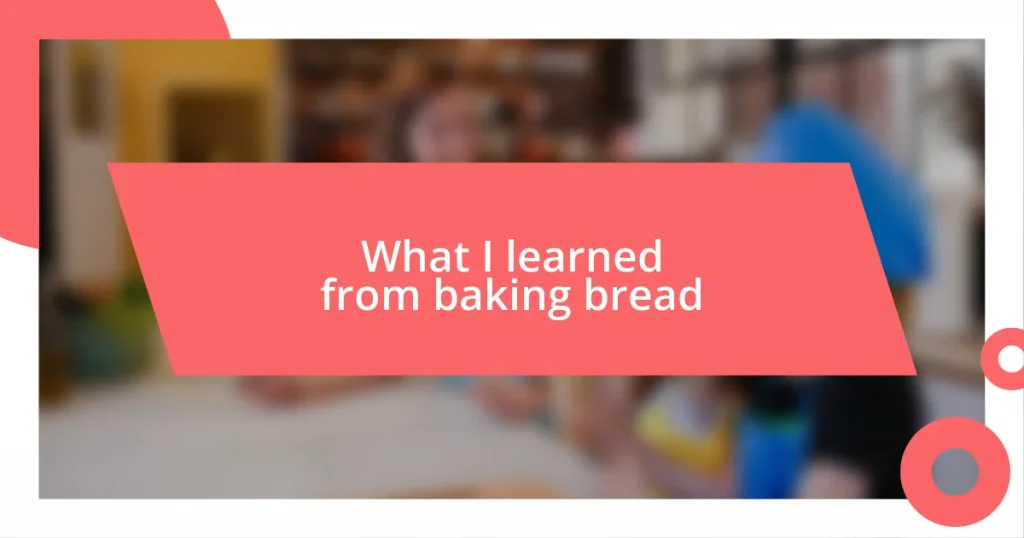Key takeaways:
- Bread baking is a therapeutic process that encourages creativity, connection, and self-expression, making it more than just a culinary task.
- Mastering essential techniques like proper kneading, proofing, and ingredient selection is crucial for achieving quality homemade bread.
- Common mistakes, such as rushing proofing and using expired yeast, can lead to unsatisfactory results; patience and attention to detail are vital for success.
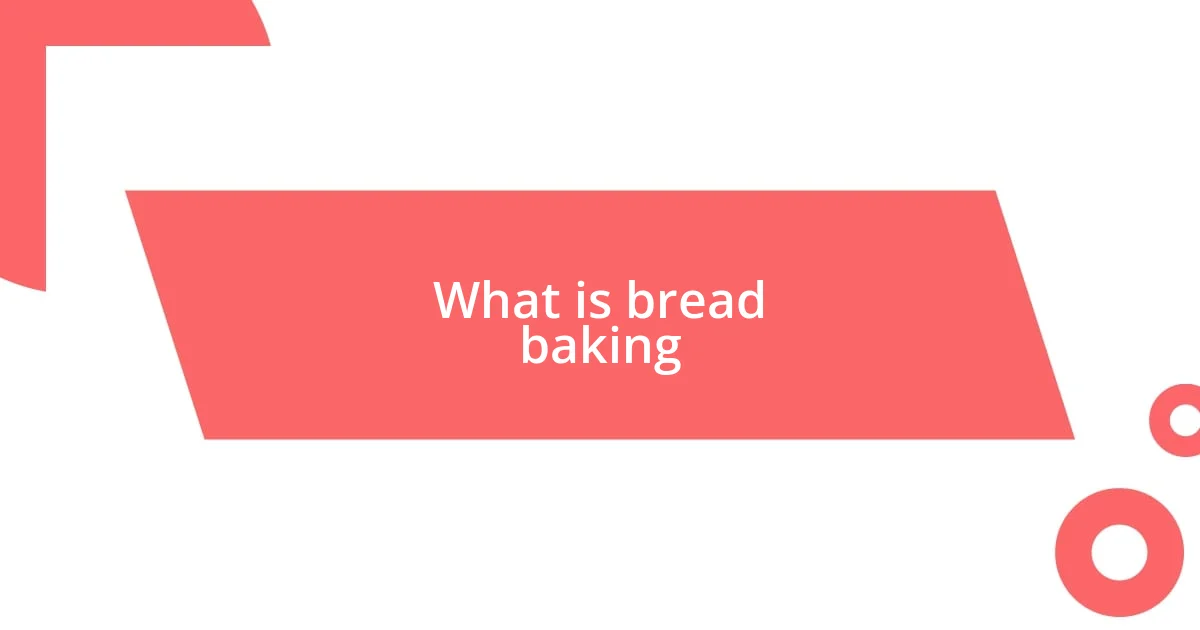
What is bread baking
Bread baking is the art of combining simple ingredients—flour, water, salt, and yeast—to create a warm, comforting staple. I still remember the first loaf I baked; the smell of rising dough wafted through my kitchen, filling me with anticipation and a sense of nostalgia. Has there ever been a moment when the smell of baking bread transported you to a place filled with warmth and joy?
At its essence, bread baking is both an ancient craft and a therapeutic process. It invites you to slow down and be present, turning the kitchen into a sanctuary where you can reflect on your day. As I kneaded the dough, I felt my worries fade, each fold releasing tension and grounding me in the moment.
The beauty of bread baking lies in its simplicity; yet, it requires a fine balance of science and intuition. When I experimented with adding herbs to my dough, I couldn’t help but feel a childlike excitement. How do you find that perfect balance between creativity and tradition in your baking? For me, exploring flavors has become a delightful journey of self-expression.
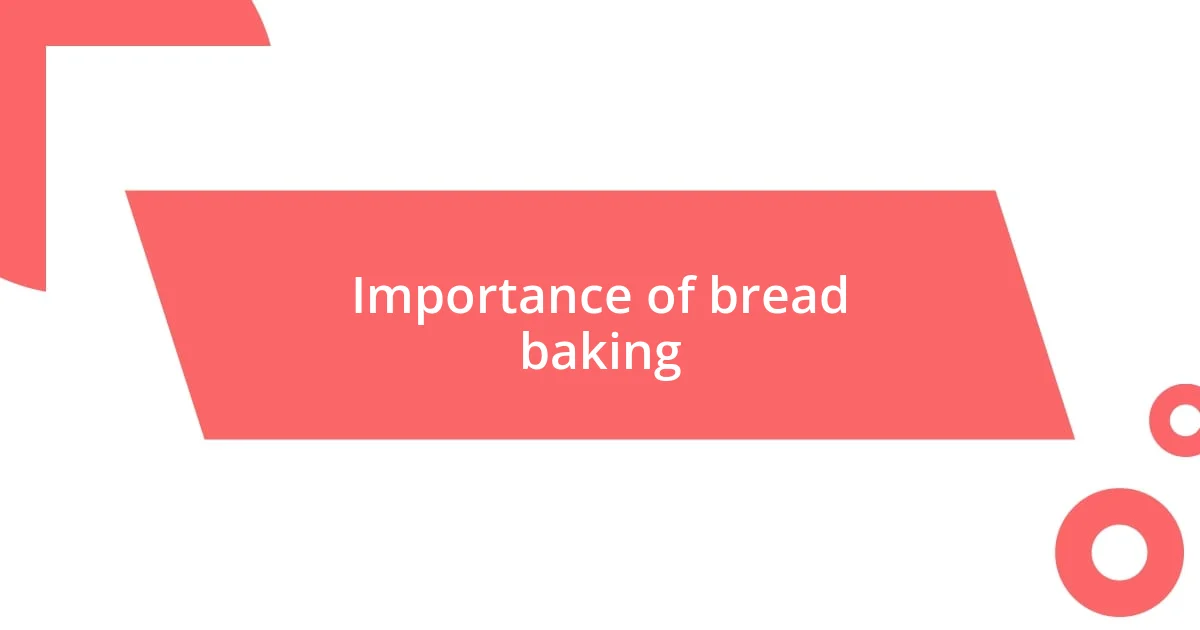
Importance of bread baking
Baking bread is more than a culinary task; it’s a profound journey into you and culture. I remember the first time I shared my homemade sourdough with friends – their faces lit up, reflecting a shared history of comfort and tradition. Bread is a universal language, speaking to our connections through the simple act of breaking bread together.
The nutritional value of homemade bread cannot be overlooked either. Unlike store-bought loaves often packed with preservatives, my homemade bread offers wholesome ingredients and fresh flavors. I recall the pride I felt biting into my first whole grain loaf, knowing exactly what went into it, and how good it felt to nourish my body with something I created myself.
Moreover, bread baking fosters creativity by allowing us to experiment and personalize our recipes. I often find myself mixing flavors—like adding roasted garlic or experimenting with gluten-free options. Each loaf is a reflection of my mood or inspiration that day, turning my kitchen into an ever-evolving canvas flavored by my heart.
| Aspect | Importance |
|---|---|
| Connection to Culture | Brings people together through shared meals. |
| Nutritional Value | Healthier options compared to commercial breads. |
| Encouragement of Creativity | Allows experimentation with ingredients and flavors. |
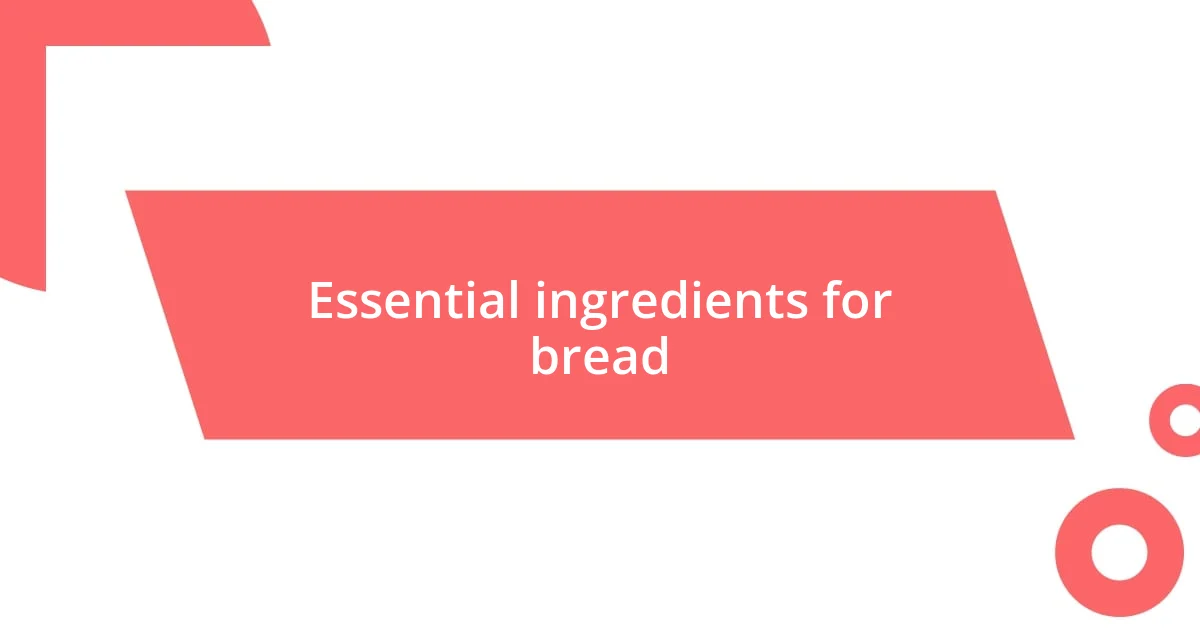
Essential ingredients for bread
The essential ingredients for bread-making may seem straightforward, but each plays a crucial role in the final product. Flour is the foundation, providing structure and texture. I’ll never forget the first time I used high-quality, unbleached flour in my dough; the difference was immediately evident in its elasticity. Water is equally important, activating the yeast and bringing the dough together, while salt not only enhances flavor but helps control fermentation. And let’s not forget yeast; it’s the magical element that causes the dough to rise, transforming it into the fluffy comfort we all love.
Here’s a quick rundown of the core ingredients for bread:
- Flour: The base, usually wheat or specialized types like whole grain.
- Water: Hydrates the flour and activates yeast.
- Yeast: The leavening agent that creates air pockets and lift.
- Salt: Enhances flavor and strengthens gluten structure.
Understanding this trio of ingredients has deepened my appreciation for the art of bread-making. I remember a time I ran out of yeast and experimented with sourdough starter instead. It was a revelation; the complexity of flavors in that loaf left my taste buds dancing. Each component contributes to the character of the bread, echoing back to both tradition and innovation.
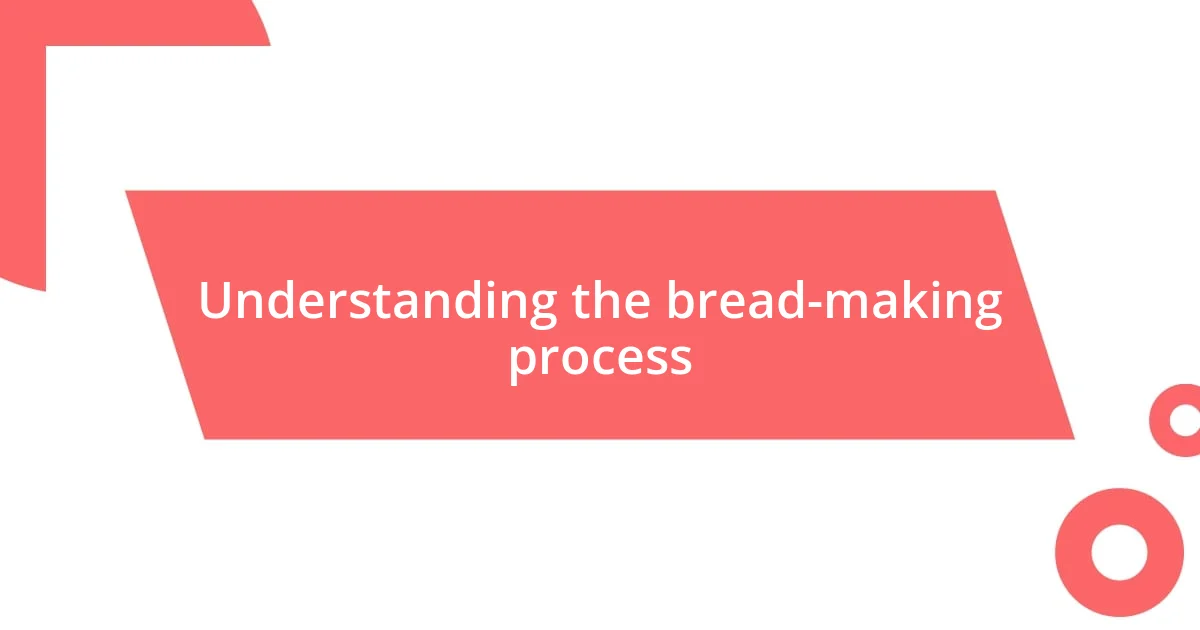
Understanding the bread-making process
As I delved into the bread-making process, I discovered that kneading is not just a physical act; it’s almost therapeutic. The rhythmic motion of folding and pressing the dough gives you a tangible connection to the loaf you’re about to create. Have you ever felt that satisfying stretch as the gluten develops? It’s like coaxing the dough to become something beautiful.
Proofing, or letting the dough rise, is where the magic truly happens. I remember the first time I confidently allowed my dough to double in size; it was a moment of anticipation that filled the kitchen with the promise of a fresh loaf. Patience really is part of the process here. I often find myself checking in on the dough, almost as if I’m waiting for a dear friend to arrive—it’s exciting to see it grow!
Finally, the baking phase transforms the dough into a perfect crusty loaf, filling the house with an irresistible aroma. I still recall the thrill of slicing into my first homemade bread, revealing that hot, steamy interior. It brought an overwhelming sense of accomplishment. What’s better than sharing that first slice with loved ones, all of us ready to savor not just the flavors but the shared experience that comes with it?
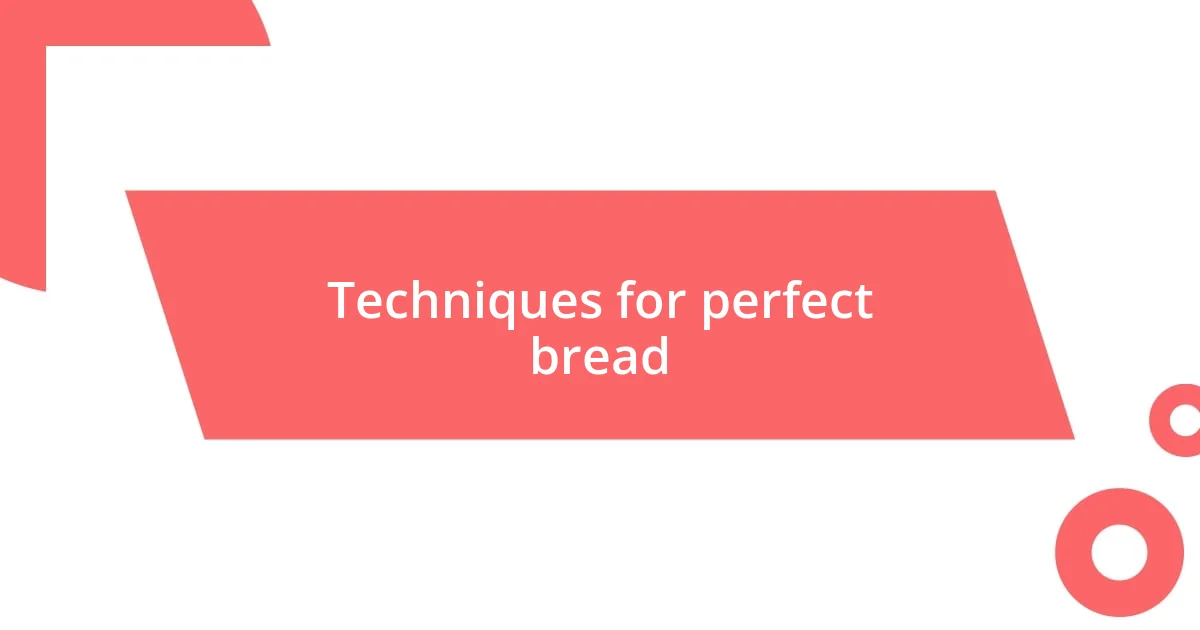
Techniques for perfect bread
To achieve perfect bread, mastering the art of kneading is essential. I remember the first time I truly committed to this technique; I spent nearly 15 minutes kneading dough that once seemed stubborn and lifeless. The moment I felt the dough transform from a sticky mass into a smooth ball was exhilarating. Have you ever felt that shift? It’s that moment where you realize you’re creating something special.
Another technique that plays a significant role is the temperature of your ingredients. Warm water can turbocharge yeast activation, which I learned the hard way during my early baking days. Using cold water left me with a flat, dense loaf, but once I embraced that warm water mythos, my breads rose beautifully. Keeping an eye on the dough’s temperature during the rise is equally important; I often tuck a kitchen thermometer into my baking routine just to ensure that my dough is at the perfect temperature for proofing.
Lastly, the impact of scoring the dough before baking cannot be understated. Initially, I was hesitant, fearing I’d ruin the loaf. However, once I made that first slash, the dough transformed as it baked, expanding beautifully and creating an artisan look. It’s like giving the bread a chance to breathe, don’t you think? Each score tells a story, and I find immense joy in those little touches that set my loaves apart from store-bought bread.
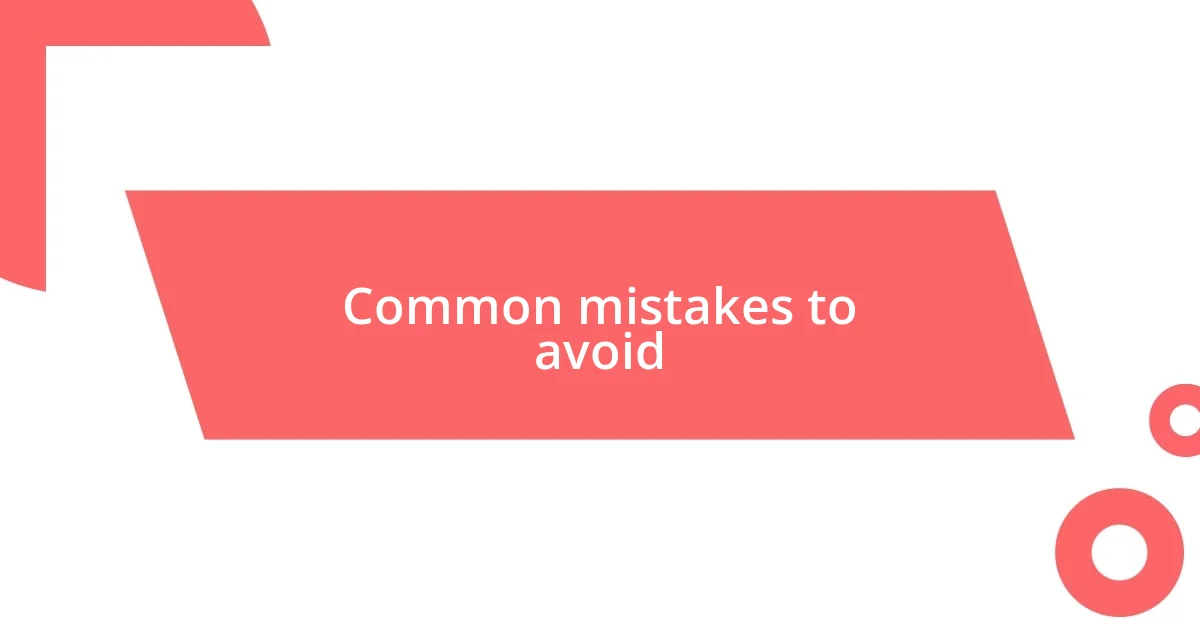
Common mistakes to avoid
One of the most common mistakes I see beginners make is rushing the proofing stage. I remember the first time I got impatient and decided to bake my dough before it had fully risen—what came out of the oven was a sad, flat loaf. Have you ever felt the disappointment of biting into a dense slice, only to realize you missed that crucial waiting period? Trust me, waiting for the dough to double is worth it; the flavor and texture you gain from proper fermentation are simply irreplaceable.
Another mistake I learned from firsthand experience is neglecting to check the expiration date on your yeast. There was one time when I was eager to bake a loaf, only to find out later that my yeast had expired. The dough didn’t rise, and I stood there bewildered, staring at my hard little lump of flour. By ensuring your yeast is fresh, you’ll avoid the frustration of putting in all that effort only to end up with a brick instead of bread.
Lastly, using the wrong flour can severely impact your results. I once grabbed all-purpose flour instead of bread flour, thinking they were interchangeable. The loaf that came out was incredibly disappointing—too dense and chewy for my liking. Different types of flour bring unique proteins to your dough, impacting the gluten structure and dough’s elasticity. So, when you’re ready to bake, make sure you select the right flour for your desired loaf. Your taste buds will thank you!
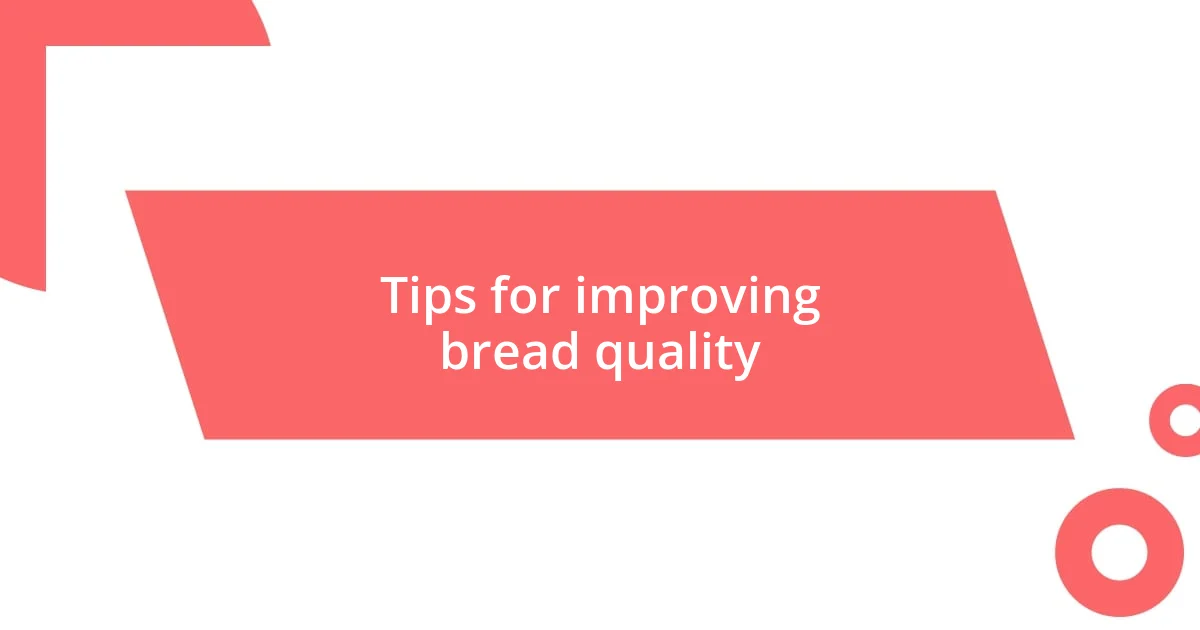
Tips for improving bread quality
To enhance the quality of your bread, consider investing time in mastering hydration levels. I distinctly remember my surprise when I first tried adjusting the amount of water in my dough. A slightly wetter dough combined with good kneading can yield an airy, light crumb. Isn’t it fascinating how a simple variable like water can transform your bread experience?
Don’t overlook the importance of flour quality either. When I switched to using organic, high-protein flour, the change was remarkable. My bread gained a richer flavor and a delightful texture that just wasn’t there before. It’s like choosing fine wine for a special dinner; the right ingredient makes all the difference and elevates your baking to a new level.
Finally, don’t hesitate to experiment with different fermentation methods. I tried an overnight cold fermentation once and was blown away by the complexity it added to the flavor of my bread. Have you ever tasted that deep, tangy flavor that develops over time? It’s like your loaf develops character while you sleep! Embracing these little tips can truly take your homemade bread from good to extraordinary.










